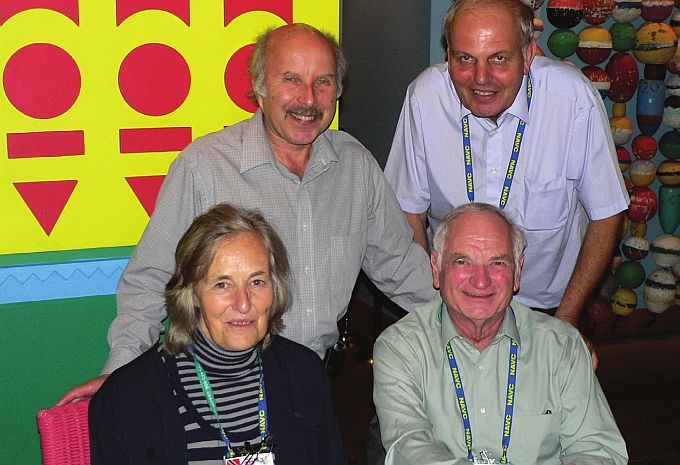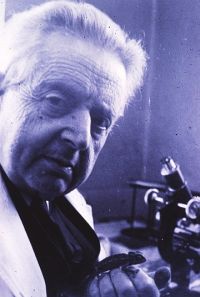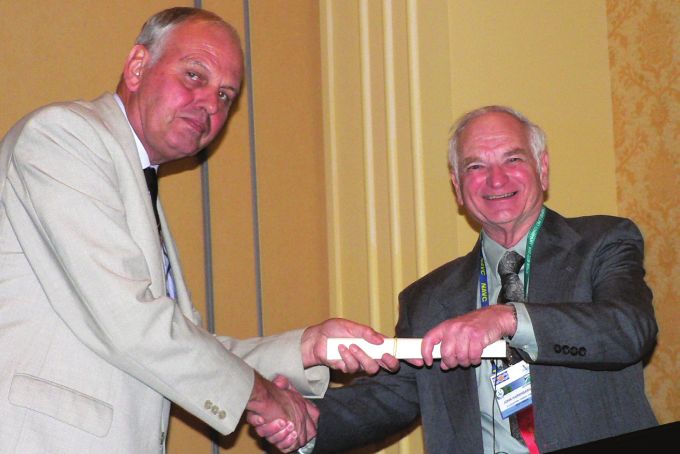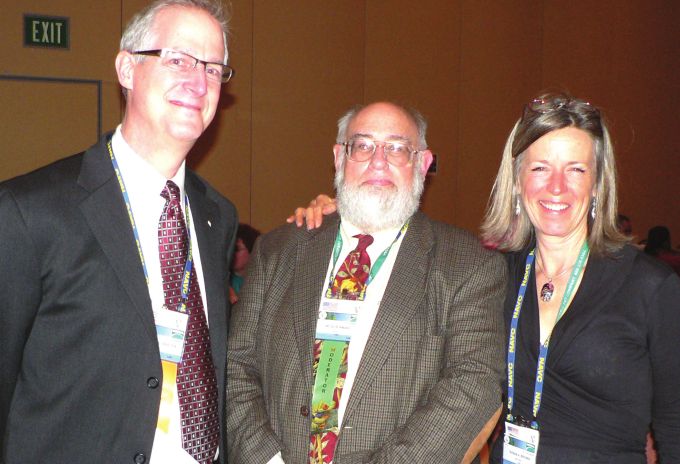John E. Cooper DTVM FRCPath FIBiol FRCVS Margaret E. Cooper LLB FLS
On the evening of Saturday 19th January 2008 the North American Veterinary Conference (NAVC) hosted the Fifth Edward Elkan Memorial Lecture at its venue in Orlando, Florida (Fig. 1). These lectures commemorate the life and work of Dr Edward Elkan, whose name will be familiar to BCG members and others who were active in herpetology in the 1970s and 1980s or who are familiar with the history of their speciality.
Dr Elkan was medically qualified, had a life-long interest in comparative pathology and was a pioneer in the study of reptiles, amphibians and fish. Following his death in 1983, a Memorial Fund was instituted. Edward Elkan’s microscope slides, gross specimens, books and reprints were put together as a teaching and research collection and a series of commemorative presentations was initiated – the Edward Elkan Memorial Lectures. The first four of these were given by John E. Cooper (UK), Fredric L. Frye (USA), Peer Zwart (The Netherlands) and Elliot R. Jacobson (USA). The Fifth, in January 2008, was presented by Dr John C. Harshbarger and entitled ‘The Chronology of Oncology: Corals to Reptiles’.
The format of the evening followed a now-familiar theme. Mrs Margaret Cooper welcomed all present and relayed messages of apology and best wishes from those who were unable to attend, including members of the Elkan family, previous Memorial Lecturers (Fig. 2), herpetologists and veterinary surgeons.
Professor John E. Cooper then gave a short introductory presentation, outlining the life and legacy of Edward Elkan. Twenty-five years had elapsed since Elkan’s death and there was now only a small, dwindling group of people who had known and worked with the man – or, like Professor Cooper, been taught by him. Edward Elkan was, he said, synonymous with pioneering studies on the diseases and pathology of reptiles and amphibians and his concern for these creatures (Fig. 3).
Born in Hamburg, Germany, in 1895, Edward Rudolph Elkan was, from an early age, an enthusiastic naturalist and this interest in biology led to his training as a medical doctor. Later, he studied tropical diseases and spent six years in Palestine, which was then under British mandate. He returned to Hamburg in 1930 and resumed medical practice. This, however, was to last for only a few years, for the pressures of Nazism forced him to leave his home country and to fee to England. After acquiring a British medical degree, he again found himself in general practice but his career began to change course in 1939 when the Second World War started and a beleaguered and embattled Britain was no longer able to bring in from overseas medical and other items, including African clawed toads (Xenopus laevis) needed for pregnancy diagnosis and other purposes. Edward Elkan established a thriving diagnostic laboratory in Britain for the production and use of Xenopus and quickly became an authority on its management, health and diseases. This led to the studies of the biology and pathology of other ectothermic vertebrates – amphibians, reptiles and fish.
In 1965 Edward Elkan co-authored Professor H. Reichenbach-Klinke in producing the first authoritative text on this subject, ‘The Principal Diseases of Lower Vertebrates, published by Academic Press. This was followed, in 1974, by the appearance of an atlas which depicted in colour the authors’ findings and observations. Edward Elkan wrote many scientific papers, most illustrated with his own photographs and line drawings, and at the time of his death, aged 88, he still had a publication in press on reptiles.
The Lecturer was introduced by Dr Steve Barten, a highly respected and experienced practising veterinarian from Chicago, who had had a life-long interest in herpetology. Dr Barten summarised the life and achievements of John Carl Harshbarger, who grew up on the family farm in Virginia, USA, and attended primary public schools. He earned a BA degree from Bridgewater College, an MS degree from Virginia Tech and a PhD degree from Rutgers University, supplemented by numerous post-graduate biomedical courses. Dr Harshbarger was a National Science Foundation Post-Doctoral Fellow with the United States Department of Agriculture from 1962 to 1964 and a Research Pathobiologist with the University of California at Irvine from 1964 to 1967. He directed the Registry of Tumors in Lower Animals at the Smithsonian institution from 1967 to 1995 and at the Department of Pathology, George Washington (GW) University Medical Center, from 1995 to 2002. In 1996 he was the recipient of the Prince Hitachi Prize for Comparative Oncology. Currently he is a Consulting Pathologist on environmental oncology. Since 2002 he has held an appointment as Adjunct Professor of Pathology at the GW University Medical Center.
Dr Barten told his audience that John Harshbarger is an author on more than 200 peer-reviewed publications on comparative oncology. Throughout his career he had worked closely with veterinarians, herpetologists, ichthyologists and others and provided them with much advice, assistance and encouragement. He is internationally recognized as a pioneer in comparative pathology, especially the study of neoplasms, and a very fitting Elkan Lecturer.
Dr Harshbarger then presented his lecture. He recalled his meetings with Dr Elkan and the latter’s unstinting support for the establishment and development of the Registry in Washington. Dr Harshbarger then traced the appearance of neoplastic disease through certain invertebrate phyla to fsh and the classes Reptilia and Amphibia. It had even been postulated, he said, that the earliest cells were neoplastic and it was only when oxygen appeared and aerobic respiration was possible that ‘normal’ cellular function commenced. Tumours of various kinds were now well-recognised in reptiles and amphibians and herpetologists could assist in research by reporting suspicious lesions in their animals and seeking prompt veterinary attention for them.
The Vote of Thanks was given by Dr Wilbur Amand, Executive Director of the Association of Reptilion and Amphibian Veterinarians (ARAV). Dr Amand expressed the gratitude of all present to those who had worked to make the evening such a success. A particular debt was owed to Dr John Harshbarger who had fown from Washington DC in order to present the lecture. Dr Harshbarger’s presentation had been a scholarly review of an important subject, the origins of cancer, that was of relevance to all. It had been a ftting tribute to Edward Elkan. Over the past 40 years the study of diseases of reptiles and amphibians had become an accepted branch of natural science. That this is so is due in no small part to the seminal work of researchers of the calibre of Edward Elkan and John Harshbarger. Their studies provided a basis for all those interested in lower vertebrates and herpetological medicine in particular owes its strong foundations to him.
Certifcates were presented to Dr Harshbarger and he, Dr Barten and Dr Amand received gifts of appreciation – hand-made models of a frog and a chameleon from East Africa (Fig. 4).
Following the formal part of the proceedings attendees were invited to a reception, generously provided by the ARAV. Veterinary surgeons, research workers and students were able to meet the speaker and to discuss herpetology, neoplastic disease and diverse other topics with him and fellow attendees (Figs 5 and 6).
Edward Elkan’s work continues to have an infuence on those who keep or study reptiles and amphibians, including BCG members and others with an interest in the health and welfare of these species. The Elkan Collection of Lower Vertebrate Pathology is currently in store in Britain but in due course will become available again for study and research. It is hoped that the Elkan Memorial Lectures will continue but this depends upon attracting more fnancial support.
Information about the Reference Collection, the Fund and the Memorial Lectures is available from the authors of this report (NGAGI2{at}gmail.com).
Testudo Volume Six Number Five 2008
Top






